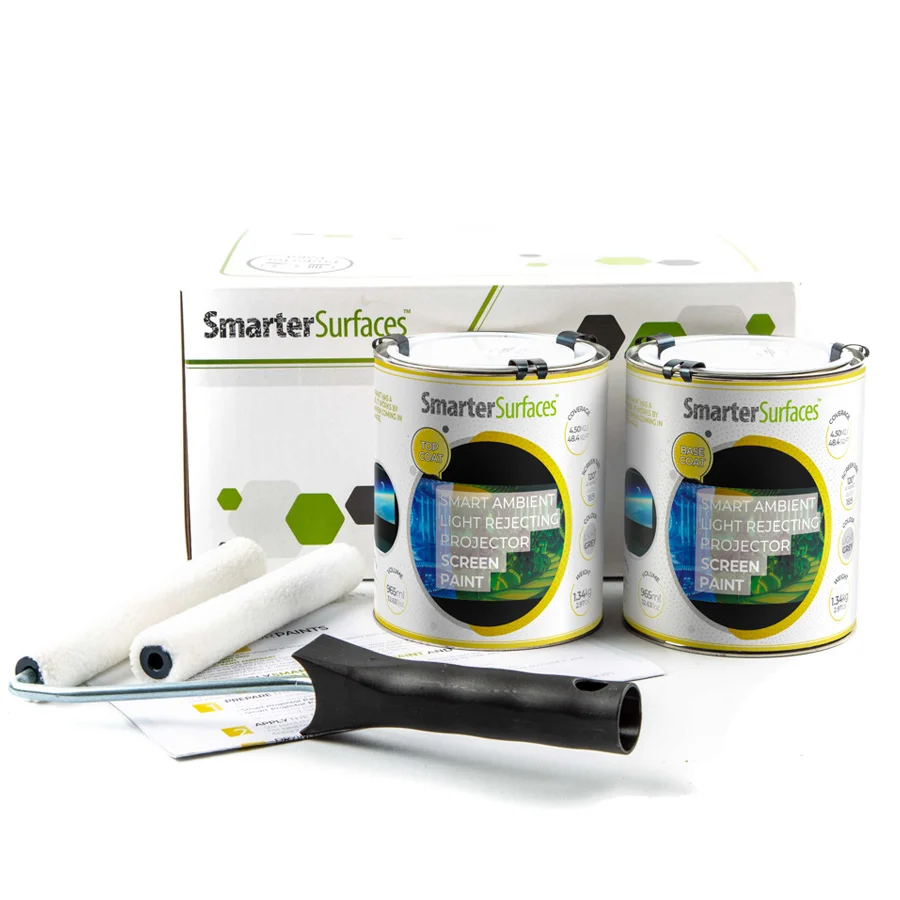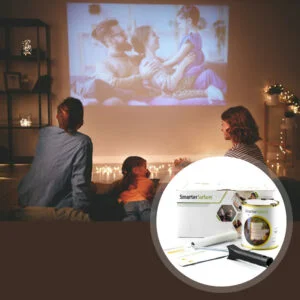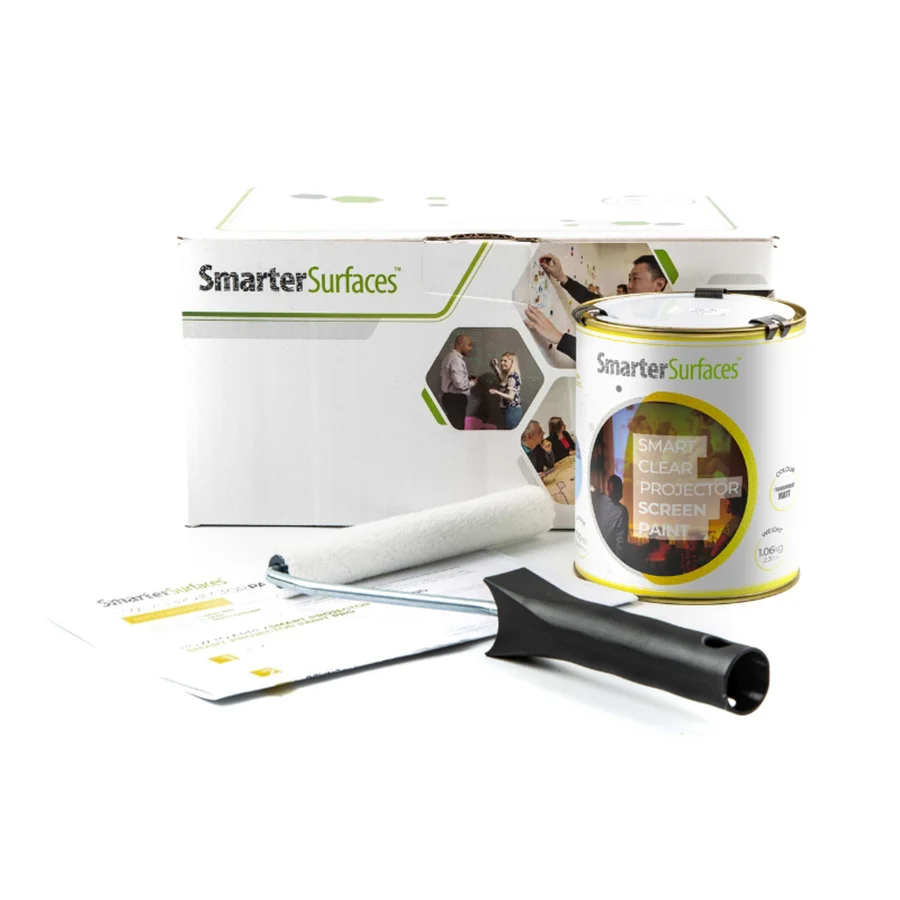Benefits of Using Smart Ambient Light Rejecting Paint (ALR Screen)
Advanced Ambient Light Rejection
Smart Ambient Light Rejecting Paint resists unwanted light ingress, selectively reflecting projector light while scattering excess light, improving image quality in brighter rooms.
Enhanced Picture Reproduction
Designed to maximize pixel definition, clarity, and rejection of ambient light, delivering luminous, high-definition images for home theaters and gaming setups.
Specular & Diffuse Reflection Reduction
Ultra matte layering technology eliminates both specular and diffuse reflection, minimizing stray light and maintaining image integrity.
Optimal Projection Performance
Tested with industry standard projectors, ensuring no hotspotting or loss of performance on regular material surfaces.
Easy Application and Sleek Finish
Quick and hassle-free application for subtle projection functionality, maintaining a minimal and sleek appearance in home theaters.
For Use With
- Projector Type: Ultra Short Throw (UST), Long Throw, Laser Projector
- Projector Requirements: Interactive, HD, 4K, Standard Projectors
- Minimum Recommended Lumen Value: 3,000 Lumens
- Lighting: works in most rooms with low to mid level ambient light
- Compatible Surfaces: can be applied to fabrics and is suitable for painting or refurbishing old screens, but not suitable for roll-up screens
Performance
- 4K & 8K Ultra HD Ready
- Gain Value @ 90 °: 0.71
- Viewing Angle: 140 degrees
- Certification: Independent Projection Performance Report – CREST
Comparison Table
Compare the performance and specifications of our full projection range
ALR Screen Paint - Technical Specifications
Color: Light Grey
Finish: Ultra Matte
Screen Size:
- 4.5 m2 : 120” / 320cm at 16:9 Aspect Ratio
- 25 m2 : 301"" / 764.5cm at 16:9 Aspect Ratio
Weight/Volume:
- 4.5 m2 : 1.19kg / 880ml
- 25 m2 : 6.58kg / 5l
Coverage:
- 4.5 m2 : 279 x 157 cm at 16:9 Aspect Ratio
- 25 m2 : 667 x 375 cm at 16:9 Aspect Ratio
Environmental (exceeds all EU/US standards): low VOC, Solvent free, PFOA & PFOS free and Isocyanates free
Odor: Very Low
VOC: Less than 0.33%
Certification: Independent Projection Performance Report – CREST, Gypsum Surface Finish Quality Standard of EU Level Q4
Unsure about the right product for you? We offer video call support, live chat, phone and email. Avail of free technical advice and suggestions for ideas and product recommendations so you can choose what will work best for you. Unsure about installation? We are here to help and advise you.
Ambient Light Rejecting – Kit Contents 4.5 m2
- ALR Screen Paint
- White Primer
- Roller
- Roller Handle
- Application Guide
Ambient Light Rejecting – Kit Contents 25 m2
- ALR Screen Paint
- Application Guide
Ambient Light Rejecting Paint Reviews
MAC AV Solutions
Finco Ltd
East Coast AV
You may also like…
FAQ's
The gain value indicates the amount of reflective lumens that the screen can provide. A higher gain value means that more light is reflected back, resulting in a brighter image on the screen. Conversely, a lower gain value means less light is reflected, resulting in a dimmer image.
The gain value of a screen also influences the width of the viewing angle. A screen with a higher gain will have a narrower viewing angle, meaning that viewers must be positioned more directly in front of the screen to experience the maximum brightness. On the other hand, a screen with a lower gain will have a wider viewing angle, allowing viewers to see a brighter image even if they are not directly in front of the screen.
It's important to note that the choice of gain depends on the specific viewing environment and the desired viewing experience. Factors such as ambient light, screen size, projector brightness, and audience seating arrangement all play a role in determining the optimal gain for a given situation.
Blending projections requires precise colour accuracy, uniform brightness, and excellent light diffusion to ensure a smooth transition between the projected images. Our projection screen paint was developed with all these aspects, allowing you to achieve a cohesive and immersive display.
When it comes to large scale screens, our projection screen paint eliminates the need for cumbersome and expensive physical screens, providing a more flexible and cost-effective solution for blending projections. Transform any space into an immersive canvas where multiple projections merge harmoniously, captivating your audience.
It's therefore really important that the projection screen you use does not change the polarity of the light if you are using a 3D projector. All of our paint products are "polarity preserving" which means that the image you see will be exactly the same polarity as is intended, preserving the full 3D effect.
The SAC can vary with the frequency of the sound waves that are passing through the material. Different frequencies of sound waves have different wavelengths, and these wavelengths can interact with the material in different ways. Therefore, the SAC values provided are a range of values, as the SAC will vary depending on the frequency of the sound waves being absorbed. In our tests we recorded the following results:
Unpainted Board α = 0.04-0.07
Painted Board α = 0.04-0.07
The values provided are for an unpainted 12mm gypsum board and a painted 12mm gypsum board. The α values of 0.04-0.07 for both the unpainted and painted board indicate the range of SAC values for these materials. This means that, when sound waves pass through a 12mm gypsum board, some of the sound energy will be absorbed by the material, with the amount of absorption falling within the range of 0.04-0.07 depending on the frequency of the sound waves. However, it also indicates that each of our paints are acoustically transparent as there is no deviation from the standard board to the painted one.
All surfaces to be painted should be clean, dry and free from loose materials. Measure the area you wish to paint and clearly mark it using masking tape unless you are painting a full wall. Apply a primer coat to bare, untreated surfaces with one coat of Smart White Primer.
Fill any defects or cracks and sand the entire surface smooth using a 120 grade sandpaper or similar. Stir the projector paint thoroughly before use. For best results, apply paint using a mohair or lint free short pile roller sleeve.
Smart ALR paint meets the highest environmental standards has been indendently certified for Fire performance and VOC. As with any paint product we recommend wearing gloves during application.
Ambient Light Rejecting Paint Installation
Smart Ambient Light Rejecting Projector Screen Paint is suitable for use on plaster, wallboards, wood, metal concrete and composites. For interior use only.
All surfaces to be painted should be clean, dry and free from loose materials. Measure the area you wish to paint and clearly mark it using masking tape.
Prime bare, untreated surfaces with one coat of Smart White Primer. Once primed, lightly sand the surface, and apply the first coat with a mohair or lint free short pile roller sleeve. Allow to dry before applying the second coat.
After 24 hours our Ambient Light Rejecting Paint is ready to use.
You can request a sample pack if you want to sample our products’ performance first.
Have any questions, or need advice? We pride ourselves on our excellent customer service and support. Just get in touch with us.
![]() A full application guide to help you apply our Ambient Light Rejecting Paint.
A full application guide to help you apply our Ambient Light Rejecting Paint.
Ambient Light Rejecting Paint installation Video
Watch our step-by-step Video Application Guide
Ambient Light Rejecting Paint Videos
Watch our step-by-step Video Application Guide
Whiteboard Paint White for Education
Whiteboard Paint White Case Study


















